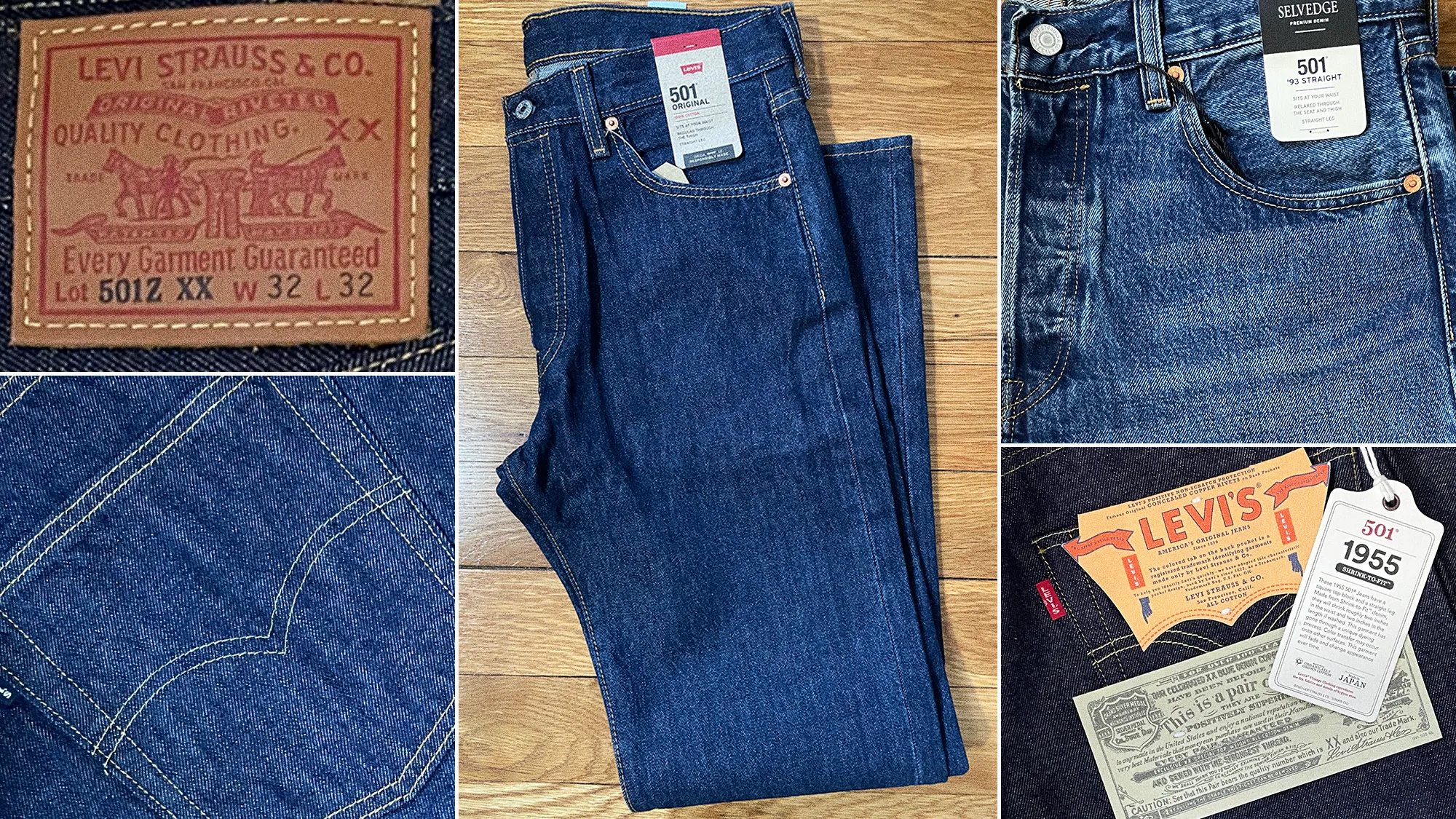By Leon Hedgepeth
Copyright gq

There are jeans, and then there’s the Levi’s 501. Launched in 1890, it’s been a mainstay of American style, GQ’s pages, and my own closet. Probably yours, too.
But here’s the rub: like Coke Classic or the McDonald’s Big Mac, the Levi’s 501 has been constantly tweaked over the decades. For a pair of jeans defined by its signature fit—straight leg, waist sitting at the hip, with an ass that hugs but doesn’t strangle, and a clean line from thigh to ankle—the 501 has gone through more facelifts than an Oscars red carpet.
On the Levi’s site today, you’ll find about 40 (!) variations of the 501, including basic versions, reproductions of vintage styles with era-specific details, the brand’s DIY Shrink-to-Fit 501, and even slim tapers (which seem to canonically violate the Tao of the 501).
So I did what needed to be done: I tried on a ton of different 501s to separate the hits from the skips. To help, Levi’s sent me 17 pairs (God bless ’em) for a full wear-test. I also grabbed a pair of 501s from Amazon—you’ll see why below. I chose similar washes for all the jeans because this test was about the fit, not judging “Northern Lights” against “Rockwell Morning” (real, actual names of current Levi’s washes). Also, I always size up in Levi’s, because I find they run a bit small, especially after a wash—but your mileage may vary.
Below are my favorite Levi’s 501s of the nearly 40 styles available. Hopefully this saves you some time as you hunt for the next pair of all-American jeans to add to your collection.
The Affordable Standard: Levi’s 501 Original
Levi’s calls this pair the “Original,” more because they represent the modern-day vision of the 501 than because they bear much connection to that 1890 pair. These hit all the important notes: quintessential 501 straight-leg fit, button fly, democratic pricing, and those instantly recognizable back pockets.
Amazingly, you can order them in varying levels of stretch—high, low, and none. For me, the correct answer is “none.” (Real 100% cotton denim will break in; stretch denim just breaks down.) But if 100%-cotton jeans feel like a full-time job to you, the low-stretch version makes the cut. I can’t look you in the eyes and abide the “high stretch” version, though.
And while we’re here, I took the opportunity to settle an age-old (okay, several-years-old) denim debate: Are the Levi’s 501s sold by Levi’s on Amazon the same as the ones from the brand’s own website? If you think this is a real tinfoil-hat question, know that plenty of brands create tweaked or cheapened versions of their products to hit an Amazon pricepoint. (And 501s are routinely marked down significantly in Bezosville.) Just to be even more suspicious: the photographs on Amazon make the back pockets look like they went on a juice cleanse compared to the ones on Levi’s site.
But I can personally confirm that, in person, they are identical. Same waistband tag, same fit, same label proudly declaring “501 Original.” Just know that navigating Amazon’s wash options should come with hazard pay.
The swatches are useless, the images are badly shot, and, just to add to the chaos, the level of stretchiness depends on the wash you choose (and possibly the size?). You’ll see what you’re getting under “fabric type”, with 100% cotton meaning no stretch, 1% elastane being low stretch, and 2% being high stretch. If you manage to actually find the right shade of denim on a pair of Amazon 501s, you should get a discount. Which it seems they’ve taken into account.
None, Low, High
The Best Overall: Levi’s 501 Original Selvedge
So you want 501s you can break in—that will become yours. And maybe you’re partial to the beauty of a finished seam on the upturned cuff of a pair of selvedge (a.k.a., “raw”) jeans. For a not entirely nominal fee, the 501 Original Selvedge has you covered.
These hit all the fit notes of the 501 Originals, plus they’ll let you write your own story in fades and wrinkles—especially in the darker washes. No, they’re not made in Japan nor as beefy as the archive-inspired Levi’s Vintage Clothing 501 versions (we’ll get to those in a minute), but the 501 Original Selvedge are something of a steal. At $150, you’re looking at one of the best-fitting, longest-lasting pairs of selvedge jeans out there.
The fit on these is closest to the ’54 501Z down below, except you get a button fly. But the real comp is a pair of vintage 501s. Unless you’ve got a plug, you’ll spend more—money, and time—for quality vintage versions, and you’ll be wearing someone else’s fades. There’s a time and a place for all that, but the 501 Original Selvedge offers a blank slate. Wear them hard, and who knows—maybe in 2055, some vintage dealer buys your pair right off you.
The DIY Experience: Levi’s 501 Original Shrink-to-Fit
There will be a lot of history lessons in here, maybe none more bar-trivia-level than this: In 1930 a man named Sanford Lockwood Cluett invented sanforization (ego naming!), an industrial process that pre-shrank cotton before being turned into clothing and goods. Up until then, all jeans (and chinos, too) shrank—a lot—upon being washed. Levi’s 501 Original Shrink-to-Fit remains un-sanforized.
As a result, they’re about as close to the original 501 experience as you can get. They require a little work, including guesswork, but they’re also the best 501s under $100 if you want to wear in a pair until they fit like they were made just for you.
The first rule of buying a pair of Shrink-to-Fit (hereafter, STF) jeans is that you always go up two sizes in both the waist and the length. I’m usually a 30 or 31 waist and a 30 inseam. For a STF pair, I’ll go 32×32 or 33×32. Trust me—they’ll shrink that much.
What comes next is a choose your own adventure. Some folks swear by wearing their STFs in the bath for 30 minutes, then wearing them until they’re dry. Those people are mildly insane. Most folks will either just soak a fresh pair of STFs in warm bathwater for half an hour, “stirring” and moving them occasionally, then letting them air-dry. Others will wash them on a warm cycle, then air-dry or—for a big shrink—run them in the dryer. All of the above will end with a lot of indigo seeping from the jeans. Avoid washing or drying them with, well, almost anything.
Me? I like to wear my brand-new STFs 10 times or so, then wash them cold and hang them to dry. I always end up with a pair of 501s that feel like they’ve been tailored to me, all for under $100. This is the magic of Levi’s STF—what made them a go-to denim brand forever, long before influencer “hacks” were a thing.
The Middle Ground: Premium 501 Original
Between the value-priced basic 501 Original and the Selvedge 501 sits this, the Premium 501 Original. No one will notice that you paid the $19 upcharge, but you’ll feel the difference. The most visible glow-up over the entry-level pair is the leather patch tag above the right back pocket, replacing the paperboard one on the entry level 501. But the real difference is a subtle improvement in the denim—it’s a little heavier, and should result in some more aesthetically pleasing fades if you’re starting with a dark wash. That said, if you can swing the Selvedge version, you’ll get the best of all worlds.
My Personal Favorite: Levi’s Vintage Clothing 1947 501
Under the Levi’s Vintage Clothing (LVC) moniker, the brand digs back into its well-tended archives to recreate nearly pitch-perfect versions of the 501 from specific eras, each with its own of-the-moment details and variations on the straight-leg fit. Though now, each is made from top-tier Japanese selvedge denim.
The 1947 Levi’s 501 was basically the blueprint for every “vintage-inspired” jean that almost every boutique denim brand is copying today. (You’ll see the same fit and “one wash” technique in orSlow’s one-wash denim, Buck Mason’s full-saddle denim, and 3sixteen’s CS “classic straight” fit.) It’s a recreation of the 501 that arrived just two years after World War II, and it marked Levi’s first real step from making workwear into making denim for everyone. Out went the back cinch and suspender buttons; in came a cleaner, sleeker silhouette.
This LVC reproduction is my all-time number one 501 fit because it puts all my favorite details in one pair of jeans: a high-rise waist, a straight leg with just enough room in the thigh, and a 14 oz. selvedge denim that’s softer than the tough-as-nails pre-war versions. Still plenty durable for modern life, but it won’t feel like you’re wearing sandpaper.
The Most Chill Fit: 501 ’93 Straight Selvedge
Two years ago I tried on a pair of Levi’s 1993 501s, and I still think they’re one of the brand’s best—and most slept-on—riffs on the legend. The fit keeps its promise of a straight leg from the knee down, with the same ankle opening, but it starts with a roomier seat and thigh. Plus there’s an ever-so-slightly higher rise (literally a quarter-inch over the Originals) to keep the whole package proportional. All of which makes perfect sense for any skaters wearing these while tearing up the Brooklyn Banks back in the day.
I’ll admit my love for these has maybe a pinch of recency bias, what with ’90s nostalgia peaking hard and a roomier jean firmly lodged in the fashion zeitgeist (despite rumors to the contrary). But a little extra breeziness, plus solid color options and selvedge denim, makes the 501 ’93 a remix that’s nearly as good as the original.
The Springsteen Fit: Blue Tab 1980’s 501
Levi’s Blue Tab, the brand’s new made-in-Japan collection, brought back one of the great moments in modern jeans history when it revived this fit, best known for highlighting Bruce Springsteen’s butt on his Born in the U.S.A. album cover. As The Boss shows, this fit remains one of the brand’s slimmest versions of the 501. That makes it maybe the perfect choice if you want to tighten things up without wandering all the way into skinny jeans territory.
This time around the jeans are made with weapons-grade Japanese selvedge denim, but they still wear the blue tab (with white lettering), as seen on all sorts of Levi’s back when Bruce was first Born to Run. Don’t be ashamed to steal his vibe with a Western-style belt, white tee, sun-faded hat, and dusty road swagger.
The One With a Zip Fly: Levi’s Vintage Clothing 1954 501
1954 saw Levi’s deliver the 501Z, the brand’s first jeans to feature a zip fly. This was radical, innovative stuff for its day. And it remains a bit of an olive branch to all the guys out there who just can’t find peace with O.G. 501’s button fly.
Though, to be clear, a zipper’s not the only differentiator here. A Levi’s insider once told me that the 1954 block (the body form it’s shaped around) is the blueprint for today’s 501s—but it’s a bit slimmer in the calf, where the ankle opening shrinks by an inch.
And since these are from the Levi’s Vintage Clothing sub-line, the 501Z gets A-grade Japanese selvedge denim and a host of secret jeans-freak details: hidden rivets on the back pockets (a 1947 debut), a leather patch (paper patches came much later), double-needle stitching on the arcuate (the iconic Levi’s batwing “logo” across the back pockets) and a Big “E” red tab, which reigned supreme from 1936 to 1971. (After that, the “e” in Levi’s went lowercase, and has largely stayed that way.)
Does a marginally tweaked red tab make the 1954 501s fit better or last longer? No. But it’s the attention to detail on the LVC-line reproductions that makes them feel special.
The Rebel Jeans: Levi’s Vintage Clothing 1955 501
The 1950s in Hollywood were all about pomade, leather jackets, and looking like you just got kicked out of a malt shop. Out went the sleek slim old fit; in came a higher rise, roomy seat and thighs, and a wide-leg opening that practically begged for a motorcycle boot. Imagine Brando smoking on a Harley, and you’ve got the idea.
Also gone: the leather “Two Horse” patch. Around 1955 Levi’s swapped it for cardboard (well, technically paperboard) that was cheaper but still durable enough to survive decades of washes and abuse.
The squarer, more relaxed shape also set the stage for future roomy hits like the 555 or 568. No ’55, no baggy jeans era. And then what would skateboarders, grunge kids, and 2000s rappers have worn?
The Unsung Fit: Levi’s Vintage Clothing 1966 501
This particular fit burned bright and faded fast. The 501 left its bad-boy era behind with a return to a slimmer fit, this time with a more pronounced taper from thigh to leg opening. The denim got lighter and softer, too. The look a little more preppy, particularly today. Jeans had arrived outside of the blue collar world.
To complete the 501’s house training, Levi’s jettisoned the hidden rivets on the back pockets for bar tacks. Cleaner, smoother, less likely to scratch your shiny new Pontiac GTO’s paint. Now, denimheads consider originals from this era—1966 to 1971—the last of the “classic” 501s, since they had the final big-E red tabs and single-needle stitching. With the LVC reproductions, though you get to keep the Golden Age alive.
The Most Relaxed: Levi’s Vintage Clothing 1937 501
The original versions of these 501s were game-changers when they arrived just after the Depression: the back pocket rivets were hidden, the now-iconic Red Tab made one of its earliest appearances, and suspender buttons were replaced with belt loops. Levi’s tossed in a free pair of suspenders with every 501 purchase in 1937, though, because they were considered denim training wheels for newcomers. Which is ironic, since nowadays, the Levi’s Vintage Clothing 1937 501s feel like they’re more for the purists.
For one, there’s the old-timey waist cinch out back—a vintage hit if ever there was one. For another, while the silhouette remains devoutly straight-leg, it’s significantly roomier from the thigh down than any of the other pairs here. At a size 32, the 1937’s knee opening is 1.75” bigger than the Original 501’s; the leg opening is two inches bigger.
What you get is a 501 that’s probably best paired with more denim, a pair of heavily cooked boots, and a lunchpail.
The Stripped-Down Throwback Fit: Levi’s Vintage Collection 1944 501
I think the 1944 501 has one of the best backstories and one of the most slept-on fits in denim history. The originals dropped right in the middle of World War II, when the U.S. government basically told every clothing manufacturer to start rationing metal, fabric, and thread. Levi’s obligingly stripped down the 501, losing the watch pocket, crotch rivets, and the entire cinch, while also swapping in the no-frills laurel leaf buttons.
The toughest cut, though? The signature looping arcuate stitching across the back pocket that made Levi’s instantly recognizable as America’s jeans. Levi’s problem-solved by printing on the “stitching”—which would wear off over time.
These days, the Levi’s Vintage Clothing 1944 501 still delivers on its Depression-era simplicity while also featuring a baggier seat, a higher rise, and a slightly looser cut than the bog-standard 501. There’s something nice about wearing them so much that the printed stitching disappears, but the Red Tab still waves proudly. Genius-level design, born out of wartime necessity.
Why Are You Here?: Premium 501 Slim Taper
Of the 17 pairs of 501s Levi’s sent me, there are some shrugworthy styles I couldn’t get excited about, like the supposedly moisture-wicking yet insulating 501 Thermoadapt, and the slightly airier 501 Lightweight. But the Slim Taper? Hard pass.
A slim, tapered 501 makes as much sense as GoreTex flip flops. Even through 135 years of nips and tucks, Levi’s signature pair has always remained a straight-leg icon. This version—snug through the thigh, with a fairly aggressive taper, and some stretch to make it all work—tosses all that out the window. I understand the impulse to just slap “501” on the tag and take advantage of name recognition, but this fit feels confused and unsatisfying. Especially since, if you want some taper, Levi’s has plenty of other great options like the 502, the 514, and the legendary 505.



